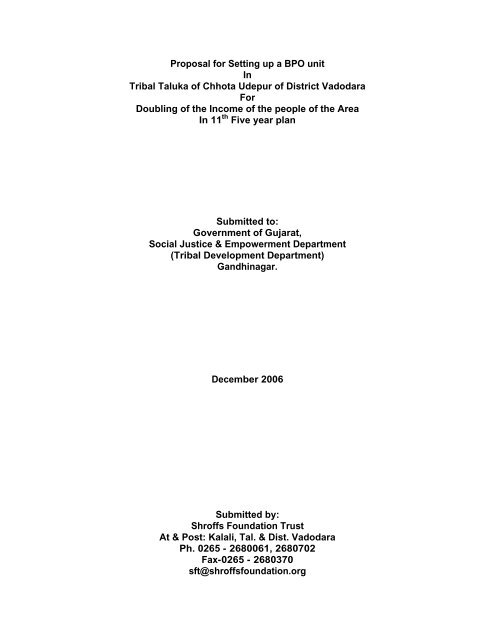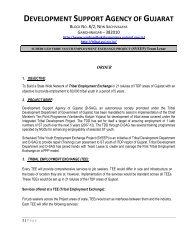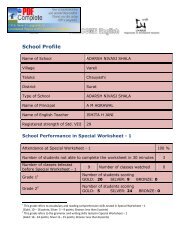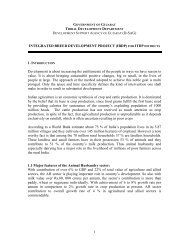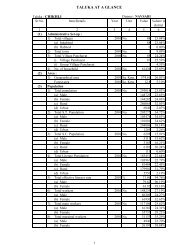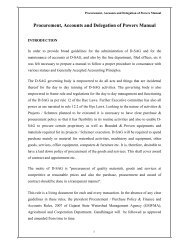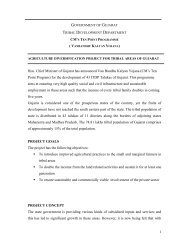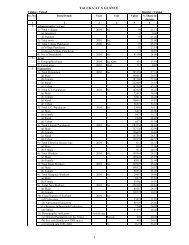Shroff Foundation Trust - Vanbandhu Kalyan Yojana - Government ...
Shroff Foundation Trust - Vanbandhu Kalyan Yojana - Government ...
Shroff Foundation Trust - Vanbandhu Kalyan Yojana - Government ...
You also want an ePaper? Increase the reach of your titles
YUMPU automatically turns print PDFs into web optimized ePapers that Google loves.
Proposal for Setting up a BPO unit<br />
In<br />
Tribal Taluka of Chhota Udepur of District Vadodara<br />
For<br />
Doubling of the Income of the people of the Area<br />
In 11 th Five year plan<br />
Submitted to:<br />
<strong>Government</strong> of Gujarat,<br />
Social Justice & Empowerment Department<br />
(Tribal Development Department)<br />
Gandhinagar.<br />
December 2006<br />
Submitted by:<br />
<strong>Shroff</strong>s <strong>Foundation</strong> <strong>Trust</strong><br />
At & Post: Kalali, Tal. & Dist. Vadodara<br />
Ph. 0265 - 2680061, 2680702<br />
Fax-0265 - 2680370<br />
sft@shroffsfoundation.org
<strong>Shroff</strong>s <strong>Foundation</strong> <strong>Trust</strong> 2<br />
Contents<br />
1. Introduction 3<br />
2. Executive Summary 4<br />
3. Overview of Outsourcing Industry 6<br />
4. BPO in Chhota Udepur 11<br />
5. Pre-requisites 12<br />
6. Project Plan 14<br />
7. Resource Requirements 15<br />
8. Financial Plan 16<br />
9. Financial Feasibility 18<br />
10. Conclusion 20
<strong>Shroff</strong>s <strong>Foundation</strong> <strong>Trust</strong> 3<br />
1. Introduction<br />
This proposal to set-up a BPO unit in Chhota Udepur is envisaged as part of the<br />
income generation program (doubling the income of the area) undertaken by<br />
SFT with private sector partnerships.<br />
The obj ective of this proposal is to build capacity among rural (tribal) youth to<br />
become BPO agents and get employment in the BPO sector which will primarily<br />
be in the rural location.<br />
The executive summary is given next which is followed by detailed description<br />
of the project including implementation plan and financials.
<strong>Shroff</strong>s <strong>Foundation</strong> <strong>Trust</strong> 4<br />
2. Executive Summary<br />
This proposal is being made to set-up a BPO (Business Process Outsourcing) unit<br />
in Chhota Udepur. Considering that the prime driver for basic BPO services is<br />
cost advantage, envisaging a model where rural infrastructure is used and<br />
process agents are also drawn from rural youth is one of the most appropriate<br />
ways of presenting such a low cost advantage to the customers who are wiling<br />
to outsource their processes.<br />
Though a rural model for BPO services may look like a non-feasible option as<br />
against a typical urban/ city BPO set-up, a number of attempts have been made<br />
to set up BPOs in rural areas and most of these attempts have been successful.<br />
In India, many BPO units have been set up in rural areas surrounding Chennai &<br />
Pondicherry and some customers outsourcing services are, in fact, thriving on<br />
such rural model.<br />
A typical BPO unit set-up requires following:<br />
1. Room/office etc.<br />
2. Computer and Server set-up including various software.<br />
3. Broadband Connectivity, preferably a leased line.<br />
4. At least one IT technician/engineer for each shift.<br />
5. At least one person with managerial skills (Team Leader) for each shift.<br />
6. Educated workforce young people ready to work in shifts.<br />
7. In most cases, English language skills, at least good reading and writing<br />
skills in English language.<br />
Considering Chhota Udepur, some of the above facilities are already available<br />
and others can be made available. The most important aspects to develop<br />
would be the connectivity and local manpower capabilities. Though<br />
connectivity can be established with the help of telecom service providers in
short time, the capacity building of the manpower is a development process<br />
and would take some time. Considering that language skills are also to be<br />
developed, a reasonable estimate of 9 months to 12 months should be taken for<br />
development of manpower to be ready to work as process agents in the BPO<br />
unit.<br />
There are some good reasons for customers to have rural BPOs attractive from<br />
a business standpoint. The main driver is cost as the infrastructure cost<br />
(physical space<br />
rental, lease or purchase) and people cost (the highest cost in<br />
a BPO) are much lower in rural areas compared to urban situation. Also, with<br />
the growth of urban areas, the cost of running BPO in a city is increasing and<br />
the cost leverage that was there five years back has considerably reduced.<br />
Moreover, the pressures on city infrastructures are creating major roadblocks in<br />
expanding the set-up in cities. For example, severe traffic j ams have become a<br />
norm in Bangalore, the biggest BPO hub in India.<br />
As we look forward, it is envisaged that rural areas are going to become focus<br />
of low-end BPO services and the urban BPO services will tend to move up the<br />
value chain and over a period of time urban areas will become the focus of<br />
high-end BPO services, generally termed as KPO (Knowledge Process<br />
Outsourcing).<br />
Considering the above, it is proposed to set-up a BPO unit in Chhota Udepur on<br />
the basis of a properly designed Proj ect Implementation Plan. This would also<br />
provide an early mover advantage as well as form a basis for replication of the<br />
model into the same and other rural locations.<br />
As a public-private partnership model, Transpek Industry Limited, Vadodara<br />
was approached and they have agreed in principle to take over this unit<br />
directly or through any of their associate/group company after 12 months and<br />
run it as a business unit wherein the tribal youth will continue to be employed<br />
and earn income.<br />
<strong>Shroff</strong>s <strong>Foundation</strong> <strong>Trust</strong> 5
Introduction<br />
<strong>Shroff</strong>s <strong>Foundation</strong> <strong>Trust</strong> 6<br />
3. Overview of Outsourcing Industry<br />
This chapter provides a general overview of the Outsourcing Industry with<br />
particular emphasis on Business Process Outsourcing (BPO). It analyses the<br />
configuration of the BPO industry in general, the national competitiveness and<br />
the business drivers for successful BPO.<br />
Concepts of BPO and KPO<br />
Defined simply, BPO is the preparation, capture, warehouse, retrieval and<br />
utilization of information for an organization. Data processing is accompanied<br />
by extracting information from a current or custom designed form, fax,<br />
catalogue, book, electronic media or an on-line entry system, while<br />
simultaneously offering an internet-based data entry and query service. This<br />
service bureau concept alleviates the need for onsite data entry personnel,<br />
Optical Character Recognition (OCR) software and hardware while ensuring the<br />
utmost integrity, accuracy and security.<br />
Knowledge Process Outsourcing (KPO) is the high-end services in outsourcing<br />
and it concerns the application of knowledge to business processes compared<br />
to low level skills in bottom-line BPO.<br />
The literature is very rich in explaining the concepts of outsourcing and two<br />
such concepts have been identified to explain the scope of the industry.<br />
The BPO actors: Saunders et al. (1997) recognize that outsourcing has two main<br />
actors: the outsourced and the outsourcer . The first is the customer or<br />
client who outsources his processes while the second, the enterprise or<br />
commonly called the vendor, delivers outsourced services. The process owner
is the organizational interface of the two enterprises during all the outsourcing<br />
activities.<br />
The BPO mechanism: Financial Times (2004) explains the mechanism of BPO<br />
whereby a BPO provider assumes primary responsibility for delivery,<br />
maintaining and developing a business process or sets of functions. Contracts<br />
are usually long-term and, in some cases, staff responsible for the outsourced<br />
function move across the customer to the provider.<br />
The two above concepts give a micro-economic dimension to BPO as a<br />
management strategy. When we look at the bigger picture and consider the<br />
macro framework, we should include a third actor: the <strong>Government</strong> or the<br />
country in which the service is being delivered. We can therefore emphasize<br />
from the very outset that BPO as an industry has three main actors: the client<br />
who requires the service, the vendor who provides it and the country which is<br />
the location from which the service is provided.<br />
Outsourcing: The Status & Potential<br />
From a general point of view, Ventoro (2004) reports that the outsourcing<br />
industry in general has the following configuration as at date:<br />
There are some 10,000 vendors offering some form of outsourcing<br />
There are offshore outsourcing vendors in over 175 countries<br />
There are some 500 <strong>Government</strong> Agencies, Trade Groups and NGOs actively<br />
campaigning to grab a larger share of the global outsourcing market<br />
Considering BPO on its own as an industry, Forrester (2004) said that while it<br />
believes the BPO market will grow to $146 billion in 2008, the market place will<br />
fragment as vendors focus on individual BPO segments like simple bulk<br />
transactions, broad shared services, high-volume vertical processes and niche<br />
vertical applications. A further analysis made by Forrester reveals that:<br />
<strong>Shroff</strong>s <strong>Foundation</strong> <strong>Trust</strong> 7
The largest segment in the BPO market will be simple bulk transactions and<br />
they predict that this segment will grow to $58 billion by 2008,<br />
The second largest segment will be broad shared services, representing a<br />
market of $57 billion in 2008<br />
High-volume vertical processes will represent a significantly smaller segment,<br />
i.e. $ 6 billion in 2008. Vertical processes include policy administration, claims<br />
and loan process applications etc.<br />
The Times (August 2003) reports that by taking advantage of lower wages<br />
overseas, U.S. Managers can cut overall costs by 25 to 40% while building a<br />
more secure and more focused workforce in the U.S.<br />
Market & Business Development (MBD) (2004) published a report on Business<br />
Computing in the UK in September 2004 in which it highlights that the sharp<br />
growth in the value of IT Professional Services largely reflects the increased<br />
trend towards BPO. The report also states that BPO which has increased its<br />
share of the total market for the aforesaid services from 36% in 2000 to a<br />
projected 42% in 2004 is believed to be the fastest growing area in the sector,<br />
particularly third party work.<br />
The above statistics no doubt confirm the growth of BPO as an Industry with a<br />
worldwide dimension<br />
<strong>Shroff</strong>s <strong>Foundation</strong> <strong>Trust</strong> 8
The Geographical Distribution of the Outsourcing Industry<br />
Outsourcing can be segregated into two typical markets: the developed vendor<br />
markets and the emerging vendor market. A short review of country locations<br />
and their specializations is opportune.<br />
The developed vendor market<br />
Rick L. Click et al. (2004) highlight five BPO international spots which have<br />
emerged around the globe, each with a field of specializations. Viz<br />
India - Financial, Healthcare, Engineering & Technical<br />
China - Manufacturing and Technical<br />
Mexico - - Manufacturing<br />
Unites States - Analysis and Creative<br />
Philippines - Administrative<br />
Strategic Direction (2004) argues that India could well be the first developing<br />
country that has used its brain power, rather than its muscles of factory labor<br />
to catapult itself into a fast-growing economy. It is not surprising that India is<br />
now recognized as the world BPO leader. The Economist (May 2004) reports<br />
that India s revenue from BPO grew by some 50% in 2003 to reach $ 3.6 billion,<br />
a feat it should repeat regularly. Mr. Rao, the Chairman of NASSCOM, the<br />
Indian BPO-Industry lobby Association, indicates that some 85% of its member s<br />
revenues are derived from America and Britain.<br />
A typical BPO Services model is depicted in the following diagram.<br />
<strong>Shroff</strong>s <strong>Foundation</strong> <strong>Trust</strong> 9
Client<br />
Interactive<br />
Services<br />
Call Center<br />
Marketing<br />
Services<br />
Telesales<br />
Order<br />
Processing<br />
Client Support<br />
Warranties<br />
Administration<br />
Client<br />
Feedback<br />
Back-Office<br />
Transactions<br />
Checks &<br />
Credit Card<br />
Processing<br />
Debtors<br />
Recovery<br />
Supplies<br />
processing<br />
Transportation<br />
Distribution<br />
Logistics<br />
Warehouse<br />
Management<br />
<strong>Shroff</strong>s <strong>Foundation</strong> <strong>Trust</strong> 10<br />
Typical BPO Services<br />
Information<br />
Technologies &<br />
Software<br />
Needs<br />
Management<br />
Applications<br />
Development<br />
Applications<br />
Testing<br />
Software<br />
development<br />
Implementation<br />
Services<br />
IT Help Desk<br />
Financial &<br />
Accounting<br />
Services<br />
Invoicing<br />
Services<br />
Accounts<br />
Payable<br />
Accounts<br />
Receivable<br />
General<br />
Accounting<br />
Internal<br />
Audit<br />
Human<br />
Resource<br />
Services<br />
Payroll<br />
Services<br />
Health care<br />
Services<br />
Recruitment<br />
Training<br />
Management<br />
Pension Fund<br />
Knowledge<br />
Management<br />
Services<br />
Data<br />
Management<br />
Centre<br />
Data mining<br />
Data<br />
Warehousing<br />
Knowledge<br />
Databank
<strong>Shroff</strong>s <strong>Foundation</strong> <strong>Trust</strong> 11<br />
4. BPO in Chhota Udepur<br />
The city of Chhota Udepur is a district center with reasonably good<br />
infrastructure and availability of young manpower. It is also well connected by<br />
road with Vadodara.<br />
A BPO can be set up in Chhota Udepur with a view to build a profitable business<br />
model for private sector and at the same time harnessing the youth population<br />
available. This is a win-win situation for the community and private sector. The<br />
private sector will get low cost skilled manpower and community will benefit<br />
by availability of employment opportunities.<br />
A typical BPO which provide basic data processing services is envisaged as a<br />
starting point. Such a process is typically at the bottom level of BPO services<br />
and requires agents that are school educated (HSC preferred, but SSC pass can<br />
also do).<br />
Generally, in BPO business, a customer likes to start at the lowest end of the<br />
services and would like to move to higher levels only when the customer<br />
expectations about quality and efficiencies are met. Once a confidence level is<br />
established, the customer would be willing to pass on higher end services which<br />
provide better revenues.<br />
The key for winning customers in BPO is to actually demonstrate the<br />
capabilities of BPO and therefore training and pilot tests are critical factors for<br />
building such capabilities.<br />
The next chapter provides details about pre-requisites that are needed to<br />
develop and demonstrate such capabilities.
<strong>Shroff</strong>s <strong>Foundation</strong> <strong>Trust</strong> 12<br />
5. Pre-requisites<br />
A BPO is a set-up around Information Technology and Manpower. Therefore,<br />
the pre-requisites for BPO business are different from typical land, building and<br />
machinery required for a traditional industry.<br />
The following are the pre-requisites for setting up a BPO business unit.<br />
Room/office etc.<br />
A proper area like an office (not necessarily air-conditioned) which has<br />
basic set-up like workstations (tables-chairs etc.) and electric connections<br />
with proper lighting. A rough estimate for space needed is to have average<br />
45 sq. ft. per employee.<br />
Computer and Server set-up including various software.<br />
These are key equipment and would need to be set-up as per specifications<br />
of the customer. This would include desktops, servers, routers, switches,<br />
racks, data storage and firewalls. The software would include operating<br />
systems, process software and database systems. The server will need to be<br />
kept in an air-conditioned and secure server room.<br />
Broadband Connectivity, preferably a leased line.<br />
It is imperative to have continuous connectivity together with a back-up in<br />
case the main like goes down. Generally, a leased line is the main set-up<br />
and back is provided with Broadband.<br />
Electricity<br />
It is necessary to have continuous availability of power to run the business.<br />
Therefore, as a back-up a generator is must.
At least one IT technician/engineer for each shift<br />
Since the set-up would be fully based on IT systems, it is critical to have<br />
availability of IT engineer full time so as to reduce down time as much as<br />
possible and also to maintain the set-up in proper condition.<br />
At least one person with managerial skills (Senior Team Leader) for each<br />
shift.<br />
The key to success lies in managing the teams of people which will have<br />
issues of working at odd hours, pressures of performance and monotony of<br />
the work being done. Therefore, a senior person with leadership and<br />
managerial capabilities is needed to manage the business.<br />
Educated workforce young people ready to work in shifts.<br />
Without educated workforce (higher secondary school, at least), no process<br />
can be carried out. Therefore, availability of such manpower and their<br />
willing ness to work in such an industry are critical. Also, the success of<br />
business is dependent on the training and therefore people with basic<br />
education are required so that they can be properly trained.<br />
In most cases, English language skills, at least good reading and writing<br />
skills in English language.<br />
Most of the outsourcing comes from US & UK and therefore the language of<br />
process is English. It may be necessary to train the employees in the<br />
language before they go for training in the computers or the outsourced<br />
process itself.<br />
<strong>Shroff</strong>s <strong>Foundation</strong> <strong>Trust</strong> 13
<strong>Shroff</strong>s <strong>Foundation</strong> <strong>Trust</strong> 14<br />
6. Project Plan<br />
The proj ect is planned to be implemented over a period of 9 to 12 months out<br />
of which about 90% of the time will be spent in training and pilot tests.<br />
The project plan can be depicted in the following diagram:<br />
Availability of Funds<br />
Project Planning<br />
Business Development<br />
Month 1/2<br />
Project Implementation Road Map<br />
Tie-up Corporate in-principle to<br />
take over the unit.<br />
Infrastructure set-up including<br />
connectivity.<br />
Month 2/3 Month 3/4<br />
Kick-off<br />
Recruitment<br />
Training<br />
Month 4/5<br />
Month<br />
Month 5/6/7/8<br />
Month 8/9/10<br />
11/12<br />
Training in Computers<br />
Training in Language<br />
Training in dummy processes.<br />
Pilots 1/2/3<br />
Go Live<br />
Currently, for the period of Training etc., the proj ect will be implemented by<br />
<strong>Shroff</strong>s <strong>Foundation</strong> <strong>Trust</strong>. Once the training is over and capabilities are built,<br />
the unit will be transferred to Transpek Industry Limited or any of its associate<br />
companies for running it as a business. Transpek has provided a Letter of Intent<br />
to this effect which is attached herewith.
Basic Assumptions<br />
<strong>Shroff</strong>s <strong>Foundation</strong> <strong>Trust</strong> 15<br />
7. Resource Requirements<br />
1. The Unit would be of 100 seats excluding the Team Leaders and Quality<br />
Assurance staff. The unit will run on two shift basis.<br />
2. A building is available on rent and is not to be bought or constructed.<br />
Resources Required<br />
A building of about 7,000 to 9,000 sq. ft. will be required<br />
considering an average space requirement of about 70 to 90 sq. ft.<br />
per person.<br />
104 Desktops, 5 Servers.<br />
Routers, switches, firewall etc. and network cabling.<br />
Appropriate software<br />
Database Application etc.<br />
Workstations 105 nos.<br />
Air Conditioned Server Room<br />
Electrification<br />
Software for Learning English Language.<br />
Operating Systems, Sever Application,
Sr.<br />
A: Capital Expenditure<br />
<strong>Shroff</strong>s <strong>Foundation</strong> <strong>Trust</strong> 16<br />
8. Financial Planning<br />
Particulars Amount Rs.<br />
1 Building Refurbishment (assumed<br />
after the building is identified).<br />
can be finalized 7,00,000<br />
2 Workstations 105 @ Rs. 7,000 per station 7,35,000<br />
3 Desktops 104 @ 23000 per desktop 23,92,000<br />
4 Servers 3 @ 1,20,000 per server 3,60,000<br />
5 Server Room with AC including Racks 3,00,000<br />
6 Switches 6 @ 25,000 1,50,000<br />
7 Firewall 1 @ 180000 1,80,000<br />
8 Router 1 @ Rs. 125,000 1,25,000<br />
9 Voice Equipments 4,00,000<br />
10 Network Cabling 2,50,000<br />
11 Software<br />
MS Office<br />
Server, CALs, Database, Operating System + 9,50,000<br />
12 Electricity Generator 10,00,000<br />
Total Investment 75,42,000<br />
B: Annual Recurring Expenses for IT/Internet Set up<br />
Sr.<br />
Particulars Amount Rs.<br />
1 BSNL Internet Connection Port Charges 2 MBPS 8,00,000<br />
2 BSNL Local Lead 1,00,000<br />
3 Annual Maintenance 5,00,000<br />
4 Software Licenses 5,00,000<br />
Total IT Recurring 19,00,000
C: Operating & Training Expenses for 12 months<br />
Sr.<br />
Particulars Amount Rs.<br />
1 Training Material & Assignments for 200 trainees 6,00,000<br />
2 English Language Teachers 8 @ Rs. 12,500 per month 12,00,000<br />
3 Computer Proficiency Teacher 8 @ Rs. 10,000 per month 9,60,000<br />
4 It Technicians 2 (1 for each shift) @ Rs. 10,000 each. 2,40,000<br />
5 Team Leader 2 (1 for each shift) @ Rs. 10,000 each. 2,40,000<br />
6 Quality Assurance Staff (2 for each shift) @ Rs. 8,000 each 3,84,000<br />
7 Online Testing 8,00,000<br />
8 Electricity 10,00,000<br />
9 Telecommunication (except Internet) 1,20,000<br />
10 Provision of Tea, Coffee etc. 2,00,000<br />
11 Trainee Stipend @ 1500 per month 36,00,000<br />
12 Traveling etc. 1,00,000<br />
13 Other expenses 2,00,000<br />
14 Contingencies @ 10% of total exp. 9,64,400<br />
Total Expenses 1,06,08,400<br />
D: Total Project Expenses<br />
A: Capital Expenditure Rs. 75,42,000<br />
B: IT/Internet Expenses Rs. 19,00,000<br />
C: Training & Operating Expense Rs. Rs. 1,06,08,400<br />
D: Management Fees for Project Rs. 20,00,000<br />
Total Cost Rs. 2,20,50,400<br />
<strong>Shroff</strong>s <strong>Foundation</strong> <strong>Trust</strong> 17
<strong>Shroff</strong>s <strong>Foundation</strong> <strong>Trust</strong> 18<br />
9. Financial Feasibility<br />
Once the proj ect is implemented and capabilities are built, the unit would be<br />
handed over to the private partner. The financial feasibility for such a unit is<br />
shown as under:<br />
A: Annual Operating Expenses (two shifts)<br />
Sr. Particulars Amount Rs.<br />
1 Continuing Training Material etc. 3,00,000<br />
2 English Language Teachers 1 @ Rs. 12,500 per month 1,50,000<br />
3 Computer Proficiency Teacher 1 @ Rs. 10,000 per 1,20,000<br />
month<br />
4 Online Testing 2,00,000<br />
5 Electricity 10,00,000<br />
6 Telecommunication (except Internet) 6,00,000<br />
7 Provision of Tea, Coffee etc. 2,00,000<br />
8 Agent Salary @ 3000 per month all inclusive for 180<br />
agents<br />
64,80,000<br />
9 Team Leader & Quality Staff Salary @ 4000 per 9,60,000<br />
month for 20 nos.<br />
10 Manager s Salary 2 @ 30,000 per month. 7,20,000<br />
11 Traveling etc. 2,00,000<br />
12 Other expenses 5,00,000<br />
13 Contingencies @ 5% of total exp. 5,71,550<br />
Total Expenses 1,20,01,500<br />
B: IT & Internet Cost<br />
Sr. Particulars Amount Rs.<br />
1 BSNL Internet Connection Port Charges 2 MBPS 8,00,000<br />
2 BSNL Local Lead 1,00,000<br />
3 Annual Maintenance 5,00,000<br />
4 Software Licenses 5,00,000<br />
Total IT Recurring 19,00,000<br />
Total Expenses Rs. 1,39,01,500<br />
Annual Depreciation Rs. 25,14,000<br />
Total Costs Rs. 1,64,15,500
Financial Feasibility Calculation<br />
Sr. Particulars<br />
1 Total Annual Costs Rs. 1,64,15,500<br />
2 Total Working days 300<br />
3 No. of hours per day per shift 8<br />
4 No. of man-hours for 180 agents 4,32,000<br />
5 Hourly Revenue Required per agent for Break-even. Rs. 38<br />
6 Daily Revenue for Break-even per agent Rs. 304<br />
7 Average no. of Dat a Unit s Processed daily per agent<br />
300<br />
for a basic process<br />
8 Revenue per Data Unit Rs. 1.20<br />
9 Revenue per day per agent Rs. 360<br />
10 Net Surplus per agent per day Rs. 56<br />
Thus, t he proj ect is viable for even wit h a base level process. As t he<br />
capabilities of agents are built, the unit can take up higher level processes that<br />
would generate much higher per Data Unit revenue.<br />
<strong>Shroff</strong>s <strong>Foundation</strong> <strong>Trust</strong> 19
<strong>Shroff</strong>s <strong>Foundation</strong> <strong>Trust</strong> 20<br />
10. Conclusion<br />
Considering that the proj ect has all the ingredients for success and well as<br />
inherent possibility for replication in other similar areas, it is recommended to<br />
approve the project.


